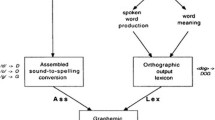Abstract
The expressive and receptive use of three written words was taught to three mute autistic adolescents using a procedure based on Terrace's errorless discrimination model and Premack's language training with chimps. Expressive language was measured by the subject's selection of the appropriate word card from among the available alternatives when the corresponding object was presented. Receptive language was measured by the subject's selection of the appropriate object from among the available alternatives when the corresponding word card was presented. The sequence of the presentations and the order of placement of the available alternatives were randomized. The three subjects required 979, 1,791, and 1,644 trials, respectively, to master both the expressive and receptive use of the three words. The correct response rates for the three subjects over the entire training program were 92, 92, and 90%, respectively. It was concluded that, as concrete visual symbols, written words may provide a viable communication system for the mute autistic. The implications for treatment are discussed and suggestions for future research are made.
Similar content being viewed by others
References
Carrier, J. K. Application of functional analysis and a nonspeech response mode to teaching language. In L. V. McReynolds (Ed.), Developing systematic procedures for training children's language.American Speech and Hearing Association Monographs, 1974,18.
Cobrinik, B. Unusual reading ability in severely disturbed children.Journal of Autism and Childhood Schizophrenia, 1974,4, 163–175.
Creedon, M. P.Language development in nonverbal autistic children using a simultaneous communication system. Paper presented to the Society for Research in Child Development, Philadelphia, March 1973. (a)
Creedon, M. P. (Ed.).Appropriate behavior through communication: A new program in simultaneous language. Chicago: Dysfunctioning Child Center at Michael Reese Medical Center, 1973. (b)
Donnellan-Walsh, A., Gossage, L., LaVigna, G. W., Schuler, A., & Traphagen, J.Teaching makes a difference: A guide for developing successful classes for autistic and other severely handicapped children. Santa Barbara County: Santa Barbara County Schools, 1976.
Eisenberg, L. Autistic children in adolescence.American Journal of Psychiatry, 1956,112, 607–612.
Eisenberg, L. The course of childhood schizophrenia.Archives of Neurological Psychiatry, 1957,78, 69–83.
Elliott, D. E., & Needleman, R. M.Hyperlexia and the relationship between speech and writing. Paper presented at the Annual Meeting of the Linguistic Society of America, San Francisco, December 1975.
Goldiamond, I. Statement on subliminal advertising. In R. Ulrich, T. Stachnik, & J. Mabry (Eds.),Control of human behavior. Glenview, Ill.: Scott, Foresman, 1966.
Hermelin, B. Rules and language. In M. Rutter (Ed.),Infantile autism: Concepts, characteristics, and treatment. London: Churchill, Livingstone, 1971.
Hermelin, B., & O'Connor, N.Psychological experiments with autistic children. London: Pergamon, 1970.
Hewett, F. M. Teaching reading to an autistic boy.The Reading Teacher, 1964,17, 613–618.
Itard, J. M. G.The wild boy of Aveyron. New York: Appleton-Century-Crofts, 1962.
Kanner, L. Autistic disturbances of affective contact.Nervous Child, 1943,2, 217–250.
LaVigna, G. W.The Itardian Reading Program. Paper presented at the 54th Annual International Convention of the Council for Exceptional Children, Chicago, April 1976.
Lockyer, L., & Rutter, M. A five-to fifteen-year follow-up study of infantile psychosis. IV. Patterns of cognitive ability.British Journal of Social and Clinical Psychology, 1970,9, 152–163.
Lotter, V. Epidemiology of autistic conditions in young children: II. Some characteristics of the parents and children.Social Psychiatry, 1967,1, 163–173.(a)
Lotter, V.The prevalence of the autistic syndrome in children. Doctoral dissertation, University of London, 1967. (b)
Lovaas, O. I., Berberick, J. P., Perloff, B. F., & Schaeffer, B. Acquisition of imitative speech in schizophrenic children.Science, 1966,151, 705–707.
Lovaas, O. I., Koegel, R., Simmons, J. Q., & Long, J. S. Some generalization and follow-up measures on autistic children in behavior therapy.Journal of Applied Behavior Analysis, 1973,6, 131–166.
Marshall, N. R., & Hegrenes, J. The use of written language as a communication system for an autistic child.Journal of Speech and Hearing Disorders, 1972,2, 258–261.
Premack, D. A functional analysis of language.Journal of Experimental Analysis of Behavior, 1970,14, 107–125.
Premack, D. Language in chimpanzees.Science, 1971,172, 808–822.
Premack, D., & Premack, A. J. Teaching visual language to apes and language-deficient persons. In R. L. Schiefelbusch and L. Lloyd (Eds.),Language perspectives-Acquisition, retardation and intervention. Baltimore: University Park Press, 1974.
Ricks, M. D., & Wing, L. Language, communication, and the use of symbols in normal and autistic children.Journal of Autism and Childhood Schizophrenia, 1975,3, 191–221.
Rimland, B.Infantile autism. New York: Appleton-Century-Crofts, 1964.
Rutter, M., Bartak, L., & Newman, S. Autism—A central disorder of cognition and language? In M. Rutter (Ed.),Infantile autism: Concepts, characteristics, and treatment. London: Churchill, Livingstone, 1971.
Rutter, M., Greenfield, D., & Lockyer, L. A five-to fifteen-year follow-up study of infantile psychosis. II. Social and behavioral outcome.British Journal of Psychiatry, 1967,113, 1183–1200.
Rutter, M., & Lockyer, L. A five-to fifteen-year follow-up study of infantile psychosis. I. Description of sample.British Journal of Psychiatry, 1967,113, 1169–1182.
Schreibman, L. Effects of within-stimulus and extra-stimulus prompting on discrimination learning in autistic children.Journal of Applied Behavior Analysis, 1975,8, 91–112.
Terrace, H. S. Discrimination learning with and without errors.Journal of Experimental Analysis of Behavior, 1963,6, 1–27.
Vygotsky, L. L.Thought and language. Cambridge, Massachusetts: M.I.T. Press, 1962.
Webster, C. D., McPherson, H., Sloman, L., Evans, M. A., & Kuchar, E. Communicating with an autistic boy by gestures.Journal of Autism and Childhood Schizophrenia, 1973,3, 337–346.
Author information
Authors and Affiliations
Rights and permissions
About this article
Cite this article
LaVigna, G.W. Communication training in mute autistic adolescents using the written word. J Autism Dev Disord 7, 135–149 (1977). https://doi.org/10.1007/BF01537725
Issue Date:
DOI: https://doi.org/10.1007/BF01537725




